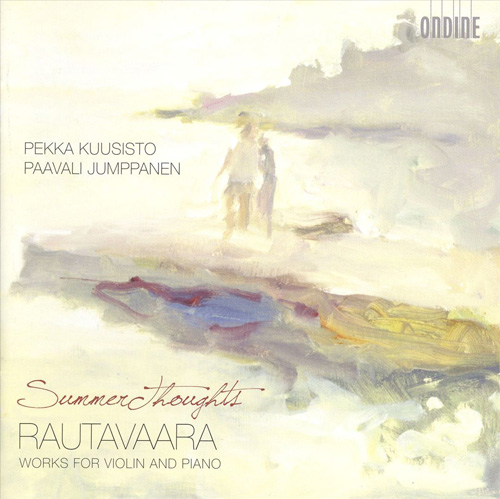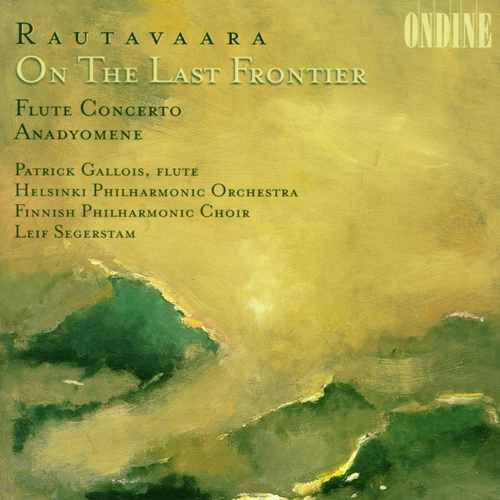Since Einojuhani Rautavaara is still actively composing, it might seem premature to label a collection his Complete Works for Male Chorus, but there is already enough material to fill out two CDs. Rautavaara is an exceptionally prolific composer, and he has been writing for men's voices since early in career; the pieces collected here span more than 50 years. The composer is a master of graceful choral writing; each piece is put together with skill and imagination. It's unfortunate that the pieces aren't presented in chronological order, since it would have been helpful to hear the composer's growth. As it is, this ordering tends to homogenize the impression of Rautavaara's styles, and while his versatility is evident from piece to piece, and individual works are striking, it's easy for a sense of monotony to set in over the course of the nearly 100 minutes of music. The composer favors dense textures and the unrelenting sound of massed a cappella low voices over such a long time tends to dull the ear and makes it easy to miss the felicities of individual works. The pieces with sections for a solo voice stand out dramatically for the textural contrast they provide. The best way to appreciate these works would be to savor a few at a time. The YL Male Voice Choir, led by Matti Hyökki, and the Talla Vocal Ensemble, led by Pasi Hyökki, sing with excellent intonation and blend, and their tone is rounded and full. Ondine's sound is present and warm; it's hard to know whether or not the engineers could have done anything to alleviate the darkness of such bass-heavy repertoire. Stephen Eddins
Tracklist & Credits :
31.8.24
RAUTAVAARA : Complete Works for Male Choir (YL Male Voice Choir · Talla Vocal Ensemble · Matti & Pasi Hyökki) 2CD (2008) FLAC (tracks+.cue) lossless
26.8.24
CARL PHILIPP EMANUEL | JOHANN CHRISTIAN | JOHANN SEBASTIAN BACH : Keyboard Concertos (Anastasia Injushina · Hamburger Camerata · Ralf Gothoni) (2013) FLAC (image+.cue) lossless
Carl Philipp Emanuel Bach (1714-1788)
[1]-[3] Concerto in D major, Wq 43/2
Johann Christian Bach (1735-1782)
[4]-[5] Concerto in D major, Op. 7/3
[6]-[8] Concerto in E flat major, Op. 7/5
Johann Sebastian Bach (1685-1750)
[9]-[11] Concerto No. II in E major, BWV 1053
Anastasia Injushina: Piano
Hamburger Camerata
Ralf Gothóni : Conductor 
17.8.24
MOZART • WINTER • HUMMEL • ROSSINI : Bassoon Concertos (Jaakko Luoma · Tapiola Sinfonietta · Janne Nisonen) (2019) FLAC (image+.cue) lossless
The material on this release by Finnish bassoonist Jaakko Luoma with the marvelous Tapiola Sinfonietta under Janne Nisonen may seem obscure enough to be aimed at bassoonists only. They will certainly find a valuable repertory here, but the album is of considerably wider interest. The only remotely familiar work is the Bassoon Concerto in B flat major, K. 191, by the young Mozart, an elegant work in the French style that receives a suitably bittersweet performance. The program opens with Hummel's Bassoon Concerto in F major, WoO 23, never published and rarely played since it was first composed. It shows Hummel in an unusually Mozartian mode, revealing its authorship mostly in the expansive first movement. The second half of the program contains the real find. Peter von Winter's single-movement Bassoon Concertino is an attractive, pleasingly operatic work by this Mannheim composer who, among other things, once wrote a sequel to The Magic Flute. The Bassoon Concerto of 1845 here, credited to Rossini, is of uncertain authorship, but it doesn't matter who wrote it: it's a virtuoso showpiece of the first order, and Luoma's clean rendering is worth the price of admission. Ondine gets fine sonic results from the acoustically superb Tapiola Concert Hall. Highly recommended. James Manheim
Johann Nepomuk Hummel (1778–1837)
[1]-[3] Bassoon Concerto in F major, WoO 23
Wolfgang Amadeus Mozart (1756–1791)
[4]-[6] Bassoon Concerto in B flat major, K191
Peter von Winter (1754–1825)
[7] Bassoon Concertino in C minor
Gioacchino Rossini (1792–1868)
[8]-[10] Bassoon Concerto
Credits :
Jaakko Luoma - Bassoon
Tapiola Sinfonietta
Janne Nisonen - Concertmaster
23.2.22
20.2.22
GEORGENESCU : Symphony No.2; Chamber Symphony (Hannu Lintu) (2012) FLAC (image+.cue), lossless
George Enescu is best remembered for his evergreen Roumanian Rhapsody No. 1, but most of his music has taken a long time to enter the western repertoire. Because the Symphony No. 2 in A major and the Chamber Symphony for 12 instruments have been treated to a handful of recordings, they are perhaps more familiar to listeners than most of his works, though limited availability still keeps them from a wider audience. That's why Hannu Lintu's recording of these works for Ondine is an important contribution to the catalog, because his clear and cogent readings with the Tampere Philharmonic Orchestra have the potential to establish these pieces outside Romania. Enescu's youthful energy, gift for memorable thems, and lush post-Romantic orchestration in the style of Richard Strauss make the Symphony No. 2 an engaging piece that listeners will immediately appreciate. The Chamber Symphony was Enescu's last composition, left incomplete because of a stroke, so the work was finished by Marcel Mihalovici. It is somewhat less ingratiating because of its serious mood and comparatively thin textures, but its lyrical lines and coherent development make it accessible. Ondine's recording of the symphony is spacious and vibrant, and all the details of the score are presented in gorgeous colors. However, the sound of the Chamber Symphony is dry and close to the instruments, making its sonorities sharp and austere. by Blair Sanderson
All Tracks & Credits
13.2.22
12.2.22
RAUTAVAARA : Before the Icons; A Tapestry of Life (Leif Segerstam) (2010) FLAC (tracks+.cue), lossless

RAUTAVAARA : The 8 Symphonies (2009) 4xCD / FLAC (tracks+.cue), lossless

RAUTAVAARA : Kaivos (The Mine) (Hannu Lintu) (2011) FLAC (image+.cue), lossless

RAUTAVAARA - Summer Thoughts : Works for Violin and Piano (Kuusisto, Jumppanen) (2011) FLAC (image+.cue), lossless

RAUTAVAARA : Marjatta (Tapiola Children's Choir) (2011) FLAC (image+.cue), lossless

RAUTAVAARA : Modificata; Incantations; Toward the Horizon (Colin Currie, Truls Mørk, John Storgårds) (2012) FLAC (tracks+.cue), lossless

All Tracks & Creditas
+ last month
SUZANNE VEGA — Lover, Beloved : Songs from an Evening with Carson McCullers (2021) FLAC (tracks+.cue), lossless
Suzanne Vega has always been a songwriter with a literary sensibility, displaying a feel for character and wordplay that was noticeably more...
































.jpg)



.jpg)




